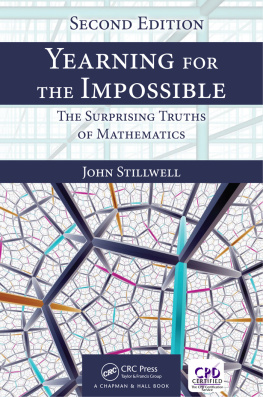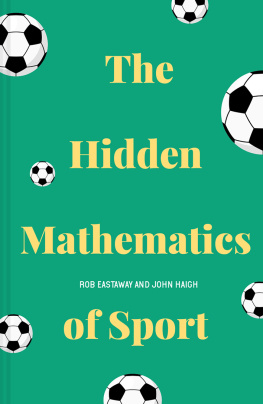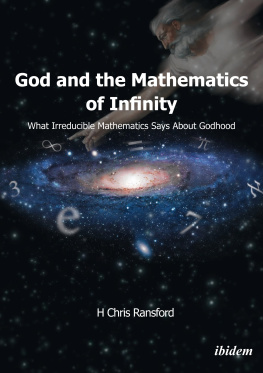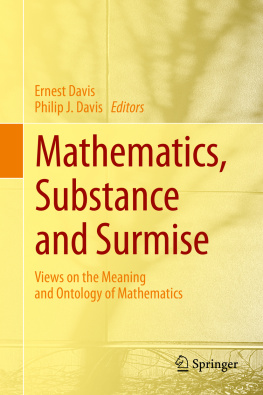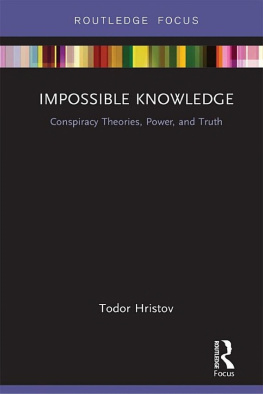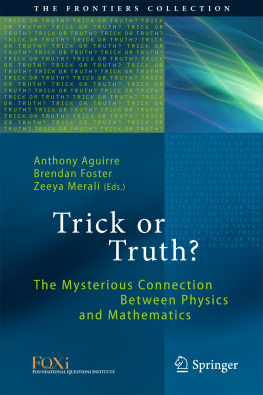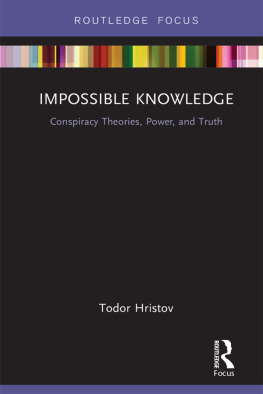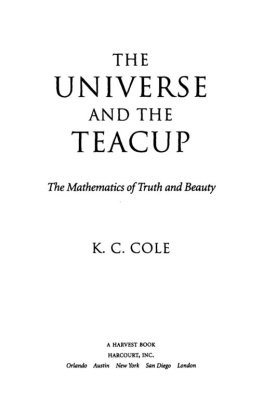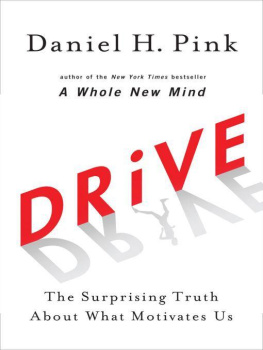Stillwell - Yearning for the impossible: the surprising truth of mathematics
Here you can read online Stillwell - Yearning for the impossible: the surprising truth of mathematics full text of the book (entire story) in english for free. Download pdf and epub, get meaning, cover and reviews about this ebook. year: 2015, publisher: CRC Press, genre: Children. Description of the work, (preface) as well as reviews are available. Best literature library LitArk.com created for fans of good reading and offers a wide selection of genres:
Romance novel
Science fiction
Adventure
Detective
Science
History
Home and family
Prose
Art
Politics
Computer
Non-fiction
Religion
Business
Children
Humor
Choose a favorite category and find really read worthwhile books. Enjoy immersion in the world of imagination, feel the emotions of the characters or learn something new for yourself, make an fascinating discovery.
Yearning for the impossible: the surprising truth of mathematics: summary, description and annotation
We offer to read an annotation, description, summary or preface (depends on what the author of the book "Yearning for the impossible: the surprising truth of mathematics" wrote himself). If you haven't found the necessary information about the book — write in the comments, we will try to find it.
Stillwell: author's other books
Who wrote Yearning for the impossible: the surprising truth of mathematics? Find out the surname, the name of the author of the book and a list of all author's works by series.
Yearning for the impossible: the surprising truth of mathematics — read online for free the complete book (whole text) full work
Below is the text of the book, divided by pages. System saving the place of the last page read, allows you to conveniently read the book "Yearning for the impossible: the surprising truth of mathematics" online for free, without having to search again every time where you left off. Put a bookmark, and you can go to the page where you finished reading at any time.
Font size:
Interval:
Bookmark:

What are numbers and what are they for? The simplest answer is that they are the whole numbers 1, 2, 3, 4, 5, (also called the natural numbers ) and that they are used for counting. Whole numbers can also be used for measuring quantities such as length by choosing a unit of measurement (such as the inch or the millimeter) and counting how many units are in a given quantity
Two lengths can be accurately compared if there is a unit that measures them both exactlya common measure . shows an example, where a unit has been found so that one line is 5 units long and the other is 7 units long. We can then say that the lengths are in the ratio of 5:7.

Figure 1.1: Finding the ratio of lengths.
If a common measure exists for any two lines, then any two lengths are in a natural number ratio. Mathematicians once dreamed of such a world in fact , a world so simple that natural numbers explain everything . However , this rational world is impossible .
The ancient Greeks discovered that there is no common measure for the side and diagonal of a square. We know that when the side is 1 the diagonal is , hence is not a ratio of natural numbers. For this reason, is called irrational .
Thus lies outside the rational world , but is it nevertheless possible to treat irrational quantities as numbers ?
It is clear that two scientific methods will lay hold of and deal with the whole investigation of quantity; arithmetic, absolute quantity, and music, relative quantity
Nicomachus, Arithmetic , Chapter III
In ancient times, higher learning was divided into seven disciplines. The first threegrammar, logic, rhetoricwere considered easier and made up what was called the trivium (which is where our word trivial comes from). The remaining fourarithmetic, music, geometry astronomymade up the advanced portion, called the quadrivium . The four disciplines of the quadrivium are naturally grouped into two pairs: arithmetic and music, and geometry and astronomy The connection between geometry and astronomy is clear enough, but how did arithmetic become linked with music?
According to legend, this began with Pythagoras and his immediate followers, the Pythagoreans. It comes down to us in the writings of later followers such as Nicomachus, whose Arithmetic quoted above was written around 100 CE.
Music was linked to arithmetic by the discovery that harmonies between the notes of plucked strings occur when the lengths of the strings are in small whole number ratios (given that the strings are of the same material and have the same tension). The most harmonious interval between notes, the octave , occurs when the ratio of the lengths is 2: 1. The next most harmonious, the fifth , occurs when the ratio of the lengths is 3:2, and after that the fourth , when the ratio is 4:3. Thus musical intervals are relative quantities because they depend, not on actual lengths, but on the ratios between them. Seeing numbers in music was a revelation to the Pythagoreans. They thought it was a glimpse of something greater: the allpervasiveness of number and harmony in the universe. In short, all is number .
We now know that there is a lot of truth in this Pythagorean dream, though the truth involves mathematical ideas far beyond the natural numbers. Still, it is interesting to pursue the story of natural numbers in music a little further, as later developments clarify and enhance their role.
The octave interval is so harmonious that we perceive the upper note in some way as the same as the lower. And we customarily divide the interval between the two into an eightnote scale (hence the terms octave, fifth, and fourth)do, re, mi, fa, so, la, ti, dowhose last note is named the same as the first so as to begin the scale for the next octave.
But why do notes an octave apart sound the same? An explanation comes from the relationship between the length of a stretched string and its frequency of vibration . Frequency is what we actually hear, because notes produced by (say) a flute and a guitar will have the same pitch provided only that they cause our eardrum to vibrate with the same frequency Now if we halve the length of a string it vibrates twice as fast, and more generally if we divide the length of the string by n , its frequency is multiplied by n . This law was first formulated by the Dutch scientist Isaac Beeckman in 1615. When combined with knowledge of the way a string produces a tone (actually consisting of many notes, which come from the modes of vibration shown in ), it shows that each tone contains the tone an octave higher. Thus it is no wonder that the two sound very much the same.
A string has infinitely many simple modes of vibration: the fundamental mode in which only the endpoints remain fixed, and higher modes in which the string vibrates as if divided into 2,3,4,5, equal parts. If the fundamental frequency is f , then the higher modes have frequencies 2 f , 3 f , 4 f , 5 f , by Beeckmans law.
When the string is plucked, it vibrates in all modes simultaneously so in theory all these frequencies can be heard (though with decreasing volume as the frequency increases, and subject to the limitation that the human ear cannot detect frequencies above about 20,000 vibrations per second). A string with half the length has fundamental frequency 2 f an octave higherand higher modes with frequencies 4 f , 6 f , 8 f , 10 f , . Thus all the frequencies of the halflength string are among those of the fulllength string.
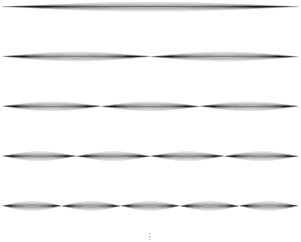
Figure 1.2: Modes ofvibration.
Since frequency doubling produces a tone that is the same only higher, repeated doubling produces tones that are perceived to increase in equal steps . This was the first observation of another remarkable phenomenon: multiplication perceived as addition . This property of perception is known in psychology as the Weber Fechner law . It also applies, approximately, to the perception of volume of sound and intensity of light. But for pitch the perception is peculiarly exact and it has the octave as a natural unit of length.
The Pythagoreans knew that addition of pitch corresponds to multiplication of ratios (from their viewpoint, ratios of lengths). For example, they knew that a fifth (multiplication of frequency by 3/2) plus a fourth (multiplication of frequency b y 4 / 3 ) equals an octave because
Thus the fifth and fourth are natural steps, smaller than the octave. Where do the other steps of the eightnote scale come from? By adding more fifths, the Pythagoreans thought, but in doing so they also found some limitations in the world of natural number ratios.
If we add two fifths, we multiply the frequency twice b y 3 / 2 . Since
the frequency is multiplied b y 9 / 4 , which is a little greater than 2. Thus the pitch is raised by a little over an octave. To find the size of the step over the octave we divide b y 2 , obtaining 9/8. The interval in pitch corresponding to multiplication of frequency by 9/8 corresponds to the second note of the scale, so it is called a second . The other notes are found similarly: we add fifths by multiplying factors of 3/2 together, and subtract octaves by dividing by 2 until the difference is an interval less than an octave (that is, a frequency ratio between 1 and 2).
Font size:
Interval:
Bookmark:
Similar books «Yearning for the impossible: the surprising truth of mathematics»
Look at similar books to Yearning for the impossible: the surprising truth of mathematics. We have selected literature similar in name and meaning in the hope of providing readers with more options to find new, interesting, not yet read works.
Discussion, reviews of the book Yearning for the impossible: the surprising truth of mathematics and just readers' own opinions. Leave your comments, write what you think about the work, its meaning or the main characters. Specify what exactly you liked and what you didn't like, and why you think so.

